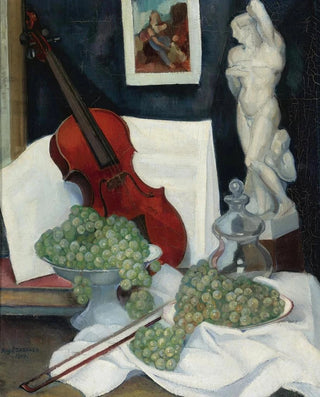Art print | Still life with violin - Ángel Zárraga


View from behind

Frame (optional)
Art print Nature morte au violon - Ángel Zárraga – Captivating introduction
At the heart of the vibrant universe of early 20th-century Mexican art, "Nature morte au violon" by Ángel Zárraga stands as an iconic work, revealing the richness of a dialogue between tradition and modernity. This piece, which captures the essence of a rapidly changing era, transports the viewer into a world where each object, each color, and each shadow tells a story. The still life, often seen as a mere exercise in style, here becomes a true ode to creativity, beauty, and melancholy, inviting deep and reflective contemplation.
Style and uniqueness of the work
The composition of "Nature morte au violon" is distinguished by a harmonious arrangement of elements that, although static, seem to vibrate with their own life. The violin, the central piece of the artwork, is surrounded by everyday objects that, far from being mere accessories, participate in expressing a rich sensory universe. The colors, both warm and earthy, evoke an intimate and nostalgic atmosphere, while the play of light accentuates textures and shapes, creating a striking contrast between shadow and clarity. Zárraga, through his unique approach, manages to turn this still life into a lively scene, where each element tells a story, and where each gaze uncovers a new facet of the work.
The artist and his influence
Ángel Zárraga, a prominent figure in Mexican art, established himself through his talent and vision. Trained alongside the greatest, he developed a style that combines the rigor of classicism with modern sensitivity. His work reflects a time of great effervescence, where European influences blend with a quest for national identity. Zárraga captured the essence of his era, offering a unique perspective on Mexican culture through various themes, ranging from still life to more symbolic representations. His legacy endures, inspiring many contemporary artists who see in him a pioneer, a visionary who managed to give voice to his time while remaining true to his roots.
A decoration

Matte finish

View from behind

Frame (optional)
Art print Nature morte au violon - Ángel Zárraga – Captivating introduction
At the heart of the vibrant universe of early 20th-century Mexican art, "Nature morte au violon" by Ángel Zárraga stands as an iconic work, revealing the richness of a dialogue between tradition and modernity. This piece, which captures the essence of a rapidly changing era, transports the viewer into a world where each object, each color, and each shadow tells a story. The still life, often seen as a mere exercise in style, here becomes a true ode to creativity, beauty, and melancholy, inviting deep and reflective contemplation.
Style and uniqueness of the work
The composition of "Nature morte au violon" is distinguished by a harmonious arrangement of elements that, although static, seem to vibrate with their own life. The violin, the central piece of the artwork, is surrounded by everyday objects that, far from being mere accessories, participate in expressing a rich sensory universe. The colors, both warm and earthy, evoke an intimate and nostalgic atmosphere, while the play of light accentuates textures and shapes, creating a striking contrast between shadow and clarity. Zárraga, through his unique approach, manages to turn this still life into a lively scene, where each element tells a story, and where each gaze uncovers a new facet of the work.
The artist and his influence
Ángel Zárraga, a prominent figure in Mexican art, established himself through his talent and vision. Trained alongside the greatest, he developed a style that combines the rigor of classicism with modern sensitivity. His work reflects a time of great effervescence, where European influences blend with a quest for national identity. Zárraga captured the essence of his era, offering a unique perspective on Mexican culture through various themes, ranging from still life to more symbolic representations. His legacy endures, inspiring many contemporary artists who see in him a pioneer, a visionary who managed to give voice to his time while remaining true to his roots.
A decoration






